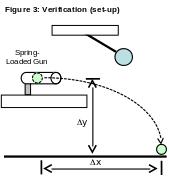PHY211 GENERAL PHYSICS I LAB PAGE 5 OF 5
PHY211 GENERAL PHYSICS I LAB PAGE 5 OF 5
Experiment: Ballistic Pendulum
Phy211:
General Physics I Lab page
PCC-Cascade
Experiment: The Ballistic Pendulum
Objectives:
Apply the Law of Conservation of Momentum to an inelastic collision
Apply the Law of Conservation of Mechanical Energy to a simple pendulum
Determine then verify the muzzle velocity of a launched projectile

Equipment:
Ballistic Pendulum apparatus
Meter stick
Digital gram scale
Carbon paper
Introduction:
The ballistic pendulum is a device commonly used to measure the muzzle velocity of firearms. When the gun is fired, the propelled projectile impacts the hanging mass (a wood block or trap) of a simple pendulum. The momentum of the projectile just prior to impact, according to the Law of Conservation of Linear Momentum, is equal to the post collision momentum of the ball and pendulum combined (inelastic collision). Moreover, the collision results in the rotation of the pendulum. The height of the pendulum swing is related to the initial velocity of the pendulum at the lowest position of the swing, according to the Law of Conservation of Mechanical Energy. The main phases of the ballistic pendulum operation are shown below in Figure 2.
In this experiment, you will utilize the ballistic pendulum to determine the muzzle velocity of a launched projectile all the while applying the concepts associated with the conservation laws for linear momentum and mechanical energy.

Preliminary Questions:
Consider a projectile (0.1 kg) fired into a ballistic pendulum (0.5 kg), the resulting collision is inelastic (see Figure 2) and the pendulum swings to a maximum angular deflection of 20o. What is the maximum PE for the pendulum?
Determine the maximum KE for the pendulum and use this value to calculate the initial velocity of the projectile-pendulum just after the collision.
Apply the Law of Conservation Momentum to calculate the initial momentum of the projectile.
Determine the velocity of the projectile.
Part 1 Ballistic Pendulum: (Procedure)
Measure the mass of the metal ball. Record in data Table 1.
Measure the mass of the pendulum. Record in the data Table 1.
Measure the length of the pendulum. Record in the data Table 1.
Cock the trigger of the spring loaded gun and load the metal ball.
Fire the projectile into the ballistic pendulum and record the deflection angle of the pendulum.
Repeat steps 4 and 5 for a total of 5 trials.
Using the angle measurements and the pendulum length (r), determine the vertical displacement (y) values for each trial. Record in Table 1.
|
Table 1: Ballistic Pendulum (Raw Data) |
|||
|
Mass of projectile: |
Mass of pendulum: |
||
|
Pendulum Length (r): |
|
||
|
Trial |
Angle () |
y |
|
|
|
|
|
|
|
|
|
|
|
|
|
|
|
|
|
|
|
|
|
|
|
|
|
|
Part 1 Ballistic Pendulum: (Analysis)
Using the data Table 1, determine the maximum gravitational potential energy for the pendulum in each trial. Record values in Table 2.
Using the gravitational potential energy values Table 2, determine the maximum kinetic energy for each trial.
Using the kinetic energy values, calculate the velocity (v1) of the pendulum/projectile system corresponding to the bottom of the swing, for each trial. Record values in Table 2.
For each trial, calculate the momentum (p1) of the pendulum-projectile system. This is the system momentum following the projectile collision with the pendulum. Record values in Table 2.
Apply the Law of Conservation of Linear Momentum to projectile-pendulum collision determine the pre-collision momentum of the fired projectile, for each trial. Record values in Table 2.
Determine the initial projectile velocity (vo) for each trial then calculate the average velocity. Record in Table 2.
Estimate
the uncertainty (![]() )
for the vo
values, using the min-max method.
)
for the vo
values, using the min-max method.
|
Table 2: Ballistic Pendulum (Analysis) |
||||||
|
|
After Collision (pendulum & projectile) |
Before Collision (projectile) |
||||
|
Trial |
Umax |
Kmax |
v1 |
p1 |
po |
vo |
|
1 |
|
|
|
|
|
|
|
2 |
|
|
|
|
|
|
|
3 |
|
|
|
|
|
|
|
4 |
|
|
|
|
|
|
|
5 |
|
|
|
|
|
|
|
|
Average vo: |
|||||
|
Uncertainty (± vo): |
||||||
Part 2 Verification: (Procedure)
Depending on the Ballistic pendulum model you are using, either: (i) remove the gun assembly from the pendulum; or (ii) position the pendulum from the gun assembly line of fire.
Position the gun so that when fired the projectile will land safely on the floor.
Measure the vertical distance (x) of the projectile from the floor. Record value in Table 3.
Fire a practice shot. Locate the landing point on the floor then secure a piece of white paper to the floor (centered about the landing point). Cover the sheet with a piece of carbon paper.
Fire the projectile at the carbon paper landing point. Repeat for a total of 5 trials.
Measure the horizontal displacement (x) for each trial and record values in Table 3.
For each trial, calculate the initial velocity (vo) of the projectile using the x and y values. Do you remember how these variables are related to the initial velocity?
Estimate
the uncertainty (![]() )
for the vo
values. Use the min-max method.
)
for the vo
values. Use the min-max method.

|
Table 3: Verification |
|||
|
Trial # |
y |
x |
vo |
|
|
|
|
|
|
|
|
|
|
|
|
|
|
|
|
|
|
|
|
|
|
|
|
|
|
|
Average vo: |
||
|
|
Uncertainty (± vo): |
||
Questions:
Why is mechanical energy not conserved in the collision of the projectile with the pendulum?
What kind of energy does the spring have when it is compressed? Where did it get it from?
What extra information about the setup would you need to calculate the work done to compress the spring in the gun?
Apply the Law of Conservation of Linear Momentum to the inelastic collision (step 2 in Figure 2) to derive a relation between vo for the projectile and v1 for the projectile-pendulum system (including the corresponding masses).
In step 3 of Figure 2, the projectile/pendulum system swings to a maximum height. Apply the Law of Conservation of Mechanical Energy to derive a relationship between the final (maximum) angle of the pendulum rotation and the initial velocity (v1) of the pendulum.
From your results in 4 and 5 (above), obtain a relationship between vo for the projectile and the maximum angle of the pendulum deflection.
Sadistic Extension:
Derive an equation for the uncertainty of the projectile velocity (vo) associated with the equation obtained in question 6.
Using your measurement data for the ballistic pendulum, calculate the uncertainty (vo) for vo. How does this value compare to uncertainty value determined in Table 2?
Tags: general physics, general, phy211, physics
- DE SOCIALE FUNCTIE VAN KINDEROPVANG VISIETEKST PLATFORM VERNIEUWING KINDEROPVANG
- INVESTIGATION OF THE ROLE OF THE P110 ISOFORM OF
- J E D I L N I K
- B2B SALGS – OG LEVERINGSBETINGELSER (SKABELON) VEJLEDNING TIL UDFYLDELSE
- LP0142012INEN “ADQUISICIÓN DE REACTIVOS PARA LABORATORIO DE INMUNOHISTOQUIMICA” BASES
- Infomrs Institute for Operations Research and the Management Science
- SETTLE COURT ROLLS [111] COURT LEET AND VIEW OF
- INFECTION PREVENTION AND CONTROL (IPC) PRACTICE GUIDANCE NOTE
- 05 HARMONOGRAM SKŁADANIA DOKUMENTÓW DOT DZIAŁALNOŚCI BADAWCZEJ W
- A SIMPLE WAY TO IMPROVE ANATOMICAL MAPPING OF FUNCTIONAL
- ZAEP 154 BAHÍA BOTÁNICA CABO GEOLOGY TIERRA VICTORIA LISTA
- HAYVANLARI KORUMA GÜNÜ AÇIKLAMA 1 CANLILAR DÜNYASI INSANLARDAN
- ¿QUÉ ES LA PSICOLOGÍA? GEORGES CANGUILHEM LA PREGUNTA ¿QUÉ
- SZKOŁA PODSTAWOWA IM KARDYNAŁA STEFANA WYSZYŃSKIEGO W WIERZCHOWISKU SERDECZNIE
- ČESKÁ GEOLOGICKÁ SLUŽBA ERROR PAGE WE ARE SORRY
- INTELLIGENT ‘AH’VE PASSED’ ‘YOU’LL GET OUT USIN
- 9 ANMELDUNG ZU DEN WEITERFÜHRENDEN SCHULEN FÜR DAS SCHULJAHR
- CATFORD REVISITED ANDREW CHESTERMAN [2012H IN DIANA SANTOS KRISTER
- CURRICULUM VITAE LIČNI PODACI PREZIMEIME LUKAČEVIĆ SELMA ADDRESA ULŠEHIDSKA
- NAME STUDENT EXPERIENCE AND ACTIVITIES (SEA) UNIT – RULES
- LIST OF WGITA COUNTRIES WHOSE CITIZENS REQUIRE VISAS TO
- TESIS LEIDAS EN LA ULPGC EN EL CURSO 20052006
- LANDSTINGSSTYRELSEN DEN 2 DECEMBER 2010 LANDSTINGSDIREKTÖRENS RAPPORT DNR
- SYLABUS PRZEDMIOTU MODUŁU KSZTAŁCENIA NAZWA PRZEDMIOTUMODUŁU KSZTAŁCENIA ZACHOWANIA
- LNK` RBJBJSS8LL) HHHHHCCCHI+CC++HH+HH+H 7R|!0) 7T8CWE QCCCCCC) ++++D
- KARTA PRACY DO DOŚWIADCZEŃ UWAGA POLA Z POLECENIAMI
- Reforma%20de%20la%20PAC
- VOCAZIONI NUOVA SERIE ANNO II LUGLIO AGOSTO 1985
- NOTIFICAÇÃO EXTRAJUDICIAL PARA RETOMADA DE IMÓVEL LOCADO (RETOMADA
- DISASTER RISK REDUCTION REPORT CONSIDERATIONS IN RANKING HAZARDS WE
 NOTA DE PRENSA JAVIER GUERRERO DIRECTOR GENERAL DE LA
NOTA DE PRENSA JAVIER GUERRERO DIRECTOR GENERAL DE LASIDE33 DAGTILBUD SAGSNR 261218 BREVID 2470980 REF HEMC DIR
 ASSET MANAGEMENT STRATEGY 2015–25 CONTENTS 2 MESSAGE FROM
ASSET MANAGEMENT STRATEGY 2015–25 CONTENTS 2 MESSAGE FROM02288 MAINE STATE BOARD FOR LICENSURE OF ARCHITECTS LANDSCAPE
46 BUDAPEST FŐVÁROS XI KERÜLET ÚJBUDA ÖNKORMÁNYZATA KULTURÁLIS ÉS
NA TEMELJU ČLANKA 3 STAVAK 1 OPĆE UREDBE O
 ALCIRA PEREZ SANMIGUEL UNIVERSIDAD DE SANTANDER CAMPUS VALLEDUPAR
ALCIRA PEREZ SANMIGUEL UNIVERSIDAD DE SANTANDER CAMPUS VALLEDUPAR  ROZBUDOWA CENTRUM INFORMATYKI RESORTU FINANSÓW WYPOSAŻENIE W SYSTEM
ROZBUDOWA CENTRUM INFORMATYKI RESORTU FINANSÓW WYPOSAŻENIE W SYSTEM ATSB TRANSPORT SAFETY REPORT AVIATION OCCURRENCE INVESTIGATION AO2012169 FINAL
ATSB TRANSPORT SAFETY REPORT AVIATION OCCURRENCE INVESTIGATION AO2012169 FINALI BENDRA INFORMACIJA PASTATAS (PATALPOS) ATSKIRAS STATINYS PATALPOS PASTATO
 PHYSICS FOR EVERYONE HTTPWWWCOLORADOCOLLEGEEDUDEPTPCREPRESENTATIVEPHYHOMEHTM KINEMATICS PROBLEMS AUGUST 1 2005
PHYSICS FOR EVERYONE HTTPWWWCOLORADOCOLLEGEEDUDEPTPCREPRESENTATIVEPHYHOMEHTM KINEMATICS PROBLEMS AUGUST 1 20052 ESTADO LIBRE ASOCIADO DE PUERTO RICO 18 VA
 ALEGACIONES AL GRUPO ASIGNADO GRADO EN PEDAGOGÍA FACULTAD DE
ALEGACIONES AL GRUPO ASIGNADO GRADO EN PEDAGOGÍA FACULTAD DEECÉDULA BREVE INSTRUCTIVO ¿CÓMO FUNCIONA? PASO 1 CONECTARSE AL
ROBERT KACPRZAK RYNKI FINANSOWE (GLOBALIZACJA) WSTĘP ZAGADNIENIA
 AVTAL OM ANVISANDE TILL KOMMUN OCH FRÄMJANDE AV INTEGRATION
AVTAL OM ANVISANDE TILL KOMMUN OCH FRÄMJANDE AV INTEGRATIONCANADIAN NATIONAL ELECTION STUDY1965 LIST OF VARIABLES V1 V2
 APÉNDICE 1 ESCALA DE VALORACIÓN SI LO REALIZA SIN
APÉNDICE 1 ESCALA DE VALORACIÓN SI LO REALIZA SIN 9 MANAGEMENT DES ORGANISATIONS TERMINALE STG PARTIE 7 –
9 MANAGEMENT DES ORGANISATIONS TERMINALE STG PARTIE 7 – B RITISH ARCHAEOLOGICAL ASSOCIATION ANNUAL GENERAL MEETING PURSUANT TO
B RITISH ARCHAEOLOGICAL ASSOCIATION ANNUAL GENERAL MEETING PURSUANT TO